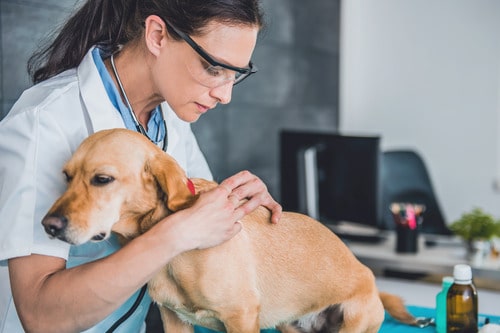Discovering a lump on your dog after removing a tick can be alarming, especially if you’re not sure what it means or how serious it might be. While tick bites are common, the reactions they trigger can vary, leaving pet owners with plenty of questions. Is the lump normal? Could it be infected? When should you seek veterinary care? At Arrowhead Animal Hospital in Westminster, CO, we’re here to help you navigate these concerns. If you’re worried about your dog’s lump or need professional advice, give us a call at (303) 469-1616 or book an appointment online today.
Why Does a Lump Form After a Tick Bite?
After a tick bites your dog, the skin may react to the tick’s saliva, causing mild inflammation. This often appears as a small, firm lump at the site of the bite. The lump can linger for several days or even weeks after the tick has been removed. In most cases, the dog tick bite lump is a result of the body’s natural immune response to the tick’s saliva. However, not all lumps are harmless. Tick bites can sometimes lead to complications, including infections or localized reactions. If the lump seems to grow, becomes warm to the touch, or causes your dog discomfort, it’s best to contact your veterinarian.
Common Reasons for a Lump After a Tick Bite
- Inflammatory Reaction: The skin’s immune response to a tick bite often results in mild swelling.
- Embedded Tick Parts: If the tick wasn’t fully removed, parts of it may remain under the skin, leading to irritation.
- Infection: Bacteria can enter the site of the bite, resulting in a localized infection.
- Tick-Borne Illnesses: While rare, some lumps can indicate an early symptom of tick-borne diseases like Lyme disease or anaplasmosis.
If you’re unsure why a lump has developed or it’s accompanied by other symptoms, such as lethargy, fever, or appetite loss, contact Arrowhead Animal Hospital at (303) 469-1616 to schedule an appointment.
How to Monitor a Dog Tick Bite Lump
When you notice a lump after a tick bite, monitoring its size, appearance, and any associated symptoms is important. This helps you determine whether the reaction is mild or if it requires veterinary attention.
- Use a ruler to measure the lump’s diameter and note its size. This helps you track whether it’s growing or shrinking over time.
- Watch for signs of redness, heat, or discharge, which may indicate an infection.
- If your dog seems to lick, scratch, or flinch when you touch the area, it could be a sign of irritation or pain.
- Keep an eye on your dog’s overall behavior. Lethargy, appetite changes, or fever may suggest a more serious issue related to the bite.
A lump that gradually decreases in size and causes no additional symptoms is generally not a cause for concern. However, if the dog tick bite lump persists for longer than a week or worsens, contact your veterinarian for further evaluation.
Signs That a Tick Bite Lump Needs Veterinary Attention
While most lumps caused by tick bites resolve on their own, some require professional care. Recognizing when to seek help is essential to protecting your dog’s health.
- Persistent growth of lump
- Redness, warmth, swelling, and discharge
- Lethargy or fever
- Limping or pain
- Changes in behavior, such as decreased appetite or increased restlessness
If you observe any of these symptoms, it’s best to have your dog examined by your veterinarian. Early intervention can prevent complications and help your dog recover more quickly. Call Arrowhead Animal Hospital at (303) 469-1616 or book an appointment online for expert care.
Potential Complications from a Dog Tick Bite Lump
In some cases, complications can develop following a tick bite. While lumps are often mild and resolve on their own, there are risks that pet owners should be aware of.
Infection at the Bite Site
If bacteria enter the bite site, an infection can occur, leading to swelling, pus, and pain. Infections may require antibiotics to resolve, so it’s important to address any signs of infection early.
Tick-Borne Diseases
Ticks can transmit diseases such as Lyme disease, Rocky Mountain spotted fever, and anaplasmosis. While a dog tick bite lump alone is not necessarily a sign of illness, it’s important to watch for additional symptoms like:
- Joint pain or limping
- Swollen lymph nodes
- Fever
- Fatigue or weakness
- Loss of appetite
Tips for Preventing Tick Bites in Dogs
Preventing tick bites is the best way to protect your dog from complications, including lumps and tick-borne illnesses. A consistent tick prevention routine can significantly reduce the risk of bites. Here are some tips for protecting your dog from tick bites:
- Use Preventive Treatments: Talk to your veterinarian about monthly flea and tick preventives, such as topical treatments, collars, or oral medications.
- Check Your Dog Regularly: After walks or outdoor play, carefully check your dog for ticks, especially around the ears, neck, underbelly, and between the toes.
- Keep Grass Short: Ticks thrive in tall grass and wooded areas. Regularly mow your yard to reduce tick habitats.
- Avoid Tick-Heavy Areas: If possible, avoid areas with dense vegetation, particularly during tick season.
- Bathe and Groom Regularly: Bathing your dog and brushing their fur can help you spot ticks more quickly.
While a dog tick bite lump is often harmless, it’s important to monitor the area closely for any changes. Tick bites can sometimes lead to infections or more serious complications, so staying vigilant ensures your dog remains happy and healthy. If you have concerns about a lump, or if your dog is showing additional symptoms, contact Arrowhead Animal Hospital in Westminster, CO, at (303) 469-1616 or book an appointment online today. Our team is here to provide the care and support your dog needs.





